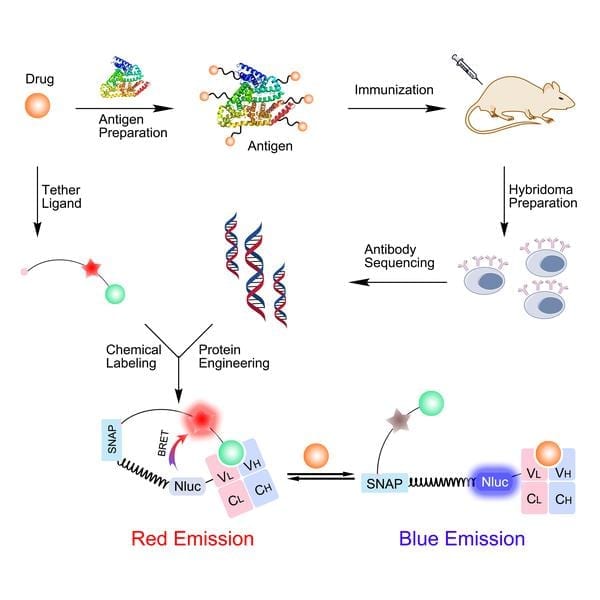
Graphene emerges as a versatile new surface to assemble model cell membranes mimicking those in the human body, with potential for applications in sensors for understanding biological processes, disease detection and drug screening.
Writing in Nature Communications, researchers at The University of Manchester led by Dr Aravind Vijayaraghavan, and Dr Michael Hirtz at the Karlsruhe Institute of Technology (KIT), have demonstrated that membranes can be directly ‘written’ on to a graphene surface using a technique known as Lipid Dip-Pen Nanolithography (L-DPN).
The human body contains 100 trillion cells, each of which is enveloped in a cell membrane which is essentially a phospholipid bi-layer membrane. These cell membranes have a plethora of proteins, ion channels and other molecules embedded in them, each performing vital functions.
It is essential, therefore, to study and understand these systems, thereby enabling their application in areas such as bio-sensing, bio-catalysis and drug-delivery. Considering that it is difficult to accomplish this by studying live cells inside the human body, scientists have developed model cell membranes on surfaces outside the body, to study the systems and processes under more convenient and accessible conditions.
Dr Vijayaraghavan’s team at Manchester and their collaborators at KIT have shown that graphene is an exciting new surface on which to assemble these model membranes, and brings many advantages compared to existing surfaces.
Dr Vijayaraghavan said: “Firstly, the lipids spread uniformly on graphene to form high-quality membranes. Graphene has unique electronic properties; it is a semi-metal with tuneable conductivity.
“When the lipids contain binding sites such as the enzyme called biotin, we show that it actively binds with a protein called streptavidin. Also, when we use charged lipids, there is charge transfer from the lipids into graphene which changes the doping level in graphene. All of these together can be exploited to produce new types of graphene/lipids based bio-sensors.”
Go deeper with Bing News on:
Biosensors
- Three McCormick Faculty Elected to American Academy of Arts and Sciences
Wei Chen, Mark C. Hersam, and Uri J. Wilensky are among the 250 members elected in 2024, and six from the University. They are recognized for their excellence and commitment to uphold the Academy’s ...
- EQS-News: XTPL records all-time high revenues, Strategy execution remains on track
Issuer: XTPL S.A. / Key word (s): Annual Results XTPL records all-time high revenues, Strategy execution remains on track 26.04.2024 / 07:30 CET/CEST The issuer is solely responsible for the ...
- Bob Marley Bikes, Mushroom Leather Sandals, Hybrid Inflatable Crazy Creeks, and More Emerging Gear
It's a great week to explore outdoor gear! Check out new tents, trail food subscriptions, and multiuse camping accessories. The post Bob Marley Bikes, Mushroom Leather Sandals, Hybrid Inflatable Crazy ...
- The UW’s Institute for Protein Design keeps boosting startups, fueling AI-powered science
On Tuesday the latest venture based on IPD technology emerged: Xaira, a San-Francisco area startup co-founded by IPD head David Baker, backed with more than $1 billion from investors including Arch ...
- The Lundquist Institute Receives $2.6 Million Grant from U.S. Army Medical Research Acquisition ...
The U.S. Army Medical Research Acquisition Activity (USAMRAA) has awarded The Lundquist Institute (TLI) a four-year grant totaling $2,623,234. The research project ...
Go deeper with Google Headlines on:
Biosensors
[google_news title=”” keyword=”biosensors” num_posts=”5″ blurb_length=”0″ show_thumb=”left”]
Go deeper with Bing News on:
Graphene based biosensors
- Conductive Ink Market Is Encouraged to Reach USD 5.6 Billion by 2033 at a CAGR of 6.3%
According to Market.us, the Conductive Ink Market size is projected to surpass around USD 5.6 billion by 2033, from USD 3.5 billion in 2023, and it is poised to reach a registered CAGR of 6.3% from ...
- Mechanical strain control of quantum transport in graphene enables new class of nanoelectronic devices
Their data again agreed with modeling based on the theory of strain-induced gauge fields in graphene. The results demonstrate that by employing strain as a knob to control electron wave interference, ...
- Scientists stencil-paint carbon nanotube components for flexible transparent electronics
Researchers from Skoltech, MIPT, and elsewhere have found a fast and inexpensive way to create geometric patterns in carbon nanotube films. The resulting films turned out to have superior properties ...
- Quantum computing, AI, and semiconductor innovations
In the dynamic landscape of technology, quantum computing and artificial intelligence (AI) emerge as transformative forces, poised to revolutionize industries and reshape investment paradigms.
- Wearable Sweat Sensors Market Size Worth $11.8 Billion by 2033; Growing Demand for Sports & Performance Monitoring to Propel Growth
Wearable sweat sensors market size from USD 3.9 billion in 2023 to USD 11.8 billion in 10 years. The increasing health consciousness among people drives the market's growth. North America's market for ...
Go deeper with Google Headlines on:
Graphene based biosensors
[google_news title=”” keyword=”graphene based biosensors” num_posts=”5″ blurb_length=”0″ show_thumb=”left”]











